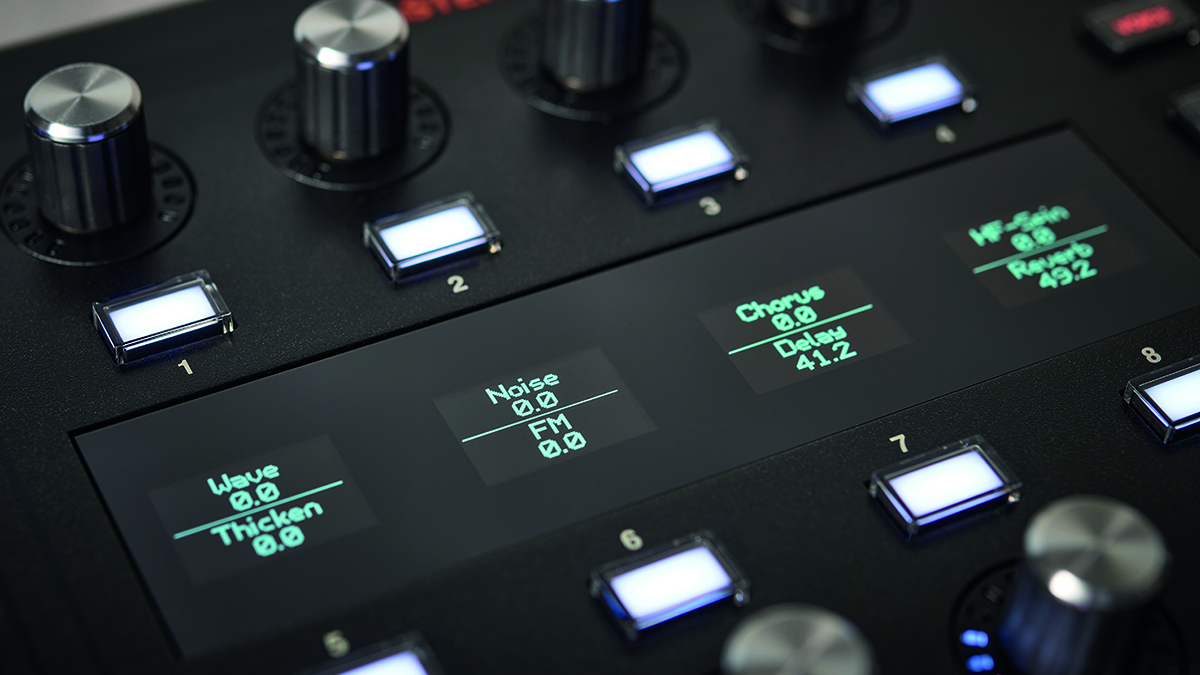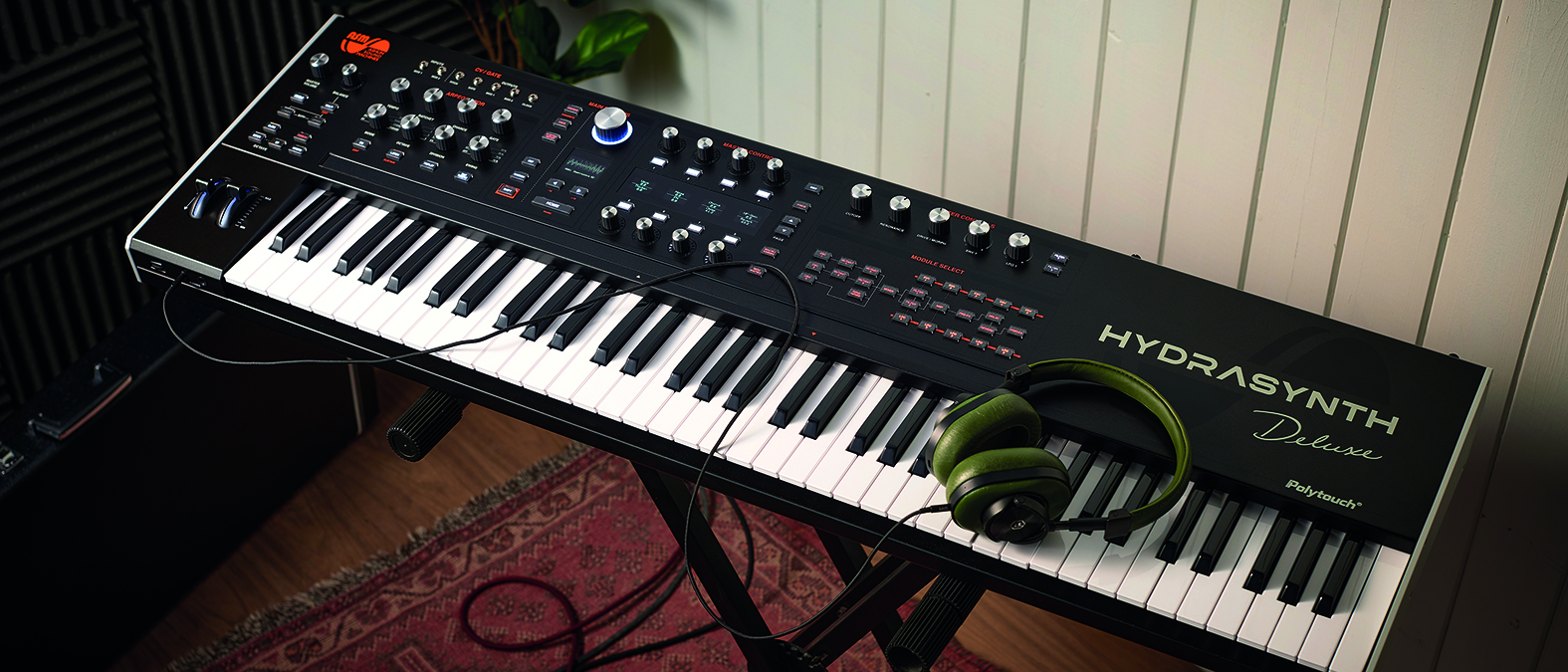MusicRadar Verdict
A great-sounding, flexible synth, ideal as a performance-led keyboard that can reach a wide range tones and textures.
Pros
- +
Extremely flexible oscillators and filter section which allow the sound engine to go from analogue-style warmth to steely FM coldness.
- +
Polyphonic aftertouch and ribbon controller really add to the realtime control possibilities.
- +
Larger keyboard and dual sound engine make this a great performance synth.
Cons
- -
Module Select buttons are all lit with the same colour even when selected, which makes navigation hard.
- -
No way to directly enter patch numbers.
MusicRadar's got your back
ASM Hydrasynth Deluxe: What is it?
ASM’s original Hydrasynth was an impressive debut, so how does one go about creating a ‘deluxe’ version? In basic terms, the Hydrasynth Deluxe combines two Hydrasynth sound engines into one unit and marries it with a 73-note keyboard. Obviously, there is a little bit more to it than that but ultimately this version is intended as the senior partner in a range that starts with a compact mini-key version (in the guise of the portable Explorer).
Hydrasynth Deluxe keeps much of the look and layout of the original, with only a few extra buttons and a balance knob on the front panel as clues to the functional difference. This means that once again you get a solid metal case, backlit buttons, OLED screens and a combination of continuous rotary encoders and pots for making parameter changes.

Programming sounds involves all of these, with a matrix of module selection buttons allowing you to dive straight to the relevant sound engine component (oscillators, filters and LFOs etc). This very much reminded us of an expanded version of that employed effectively by Ensoniq’s ESQ-1 – a classic hybrid synth from the 1980s.
The extended 73-note keyboard means that there is a large slab of free space on the top right of the synth. This, however, is quite useful for placing a laptop, mouse or additional synth, and ASM kindly provide a screw-on extension bracket which increases the depth and usefulness of this area – a nice touch.

ASM Hydrasynth Deluxe: Performance and verdict
The Hydrasynth sound engine is an all-digital affair, and in this version offers 16-voice polyphony in single mode, or two sets of eight-voice polyphony when using the dual or key split modes. The synth engine itself has three oscillators per voice. Two of the oscillators operate in both Single and Wavescan modes while the third is Single mode only.
The same range of wave shapes are available to all oscillators but Wavescan mode adds some interesting movement options not available in the more conventional single mode (which simply allows you to choose a waveform from one of the 219 on-board). Wavescan mode is closest to wavetable synthesis, though in this instance you can choose up to eight different waveforms to morph between (unlike traditional systems where you are often restricted to a specific wavetable sets).
If these were the only sound generating options then you’d already have a decent synth, but the ASM unit goes quite a bit further as each of the two main oscillators can in turn be extruded through the so-called Mutator Modules (two for each oscillator).
Want all the hottest music and gear news, reviews, deals, features and more, direct to your inbox? Sign up here.

• Modal Argon 8X
Modal’s Argon is an all-digital 8-voice wavetable synth with an impressive spec and free desktop editor/librarian app.
• ASM Hydrasynth Explorer
If you want the Hydrasynth sound engine, but don’t need the split/layering, larger keyboard or as many programming controls the Hydrasynth Explorer may be enough.
• Novation Summit
A great-sounding hybrid synth, which also has a dual mode for layering and splitting its voices.
Mutators allow you to dial-in conventional techniques such as pulse width modulation (PWM) and oscillator sync, but also extend to linear FM and oscillator stacking, to more obscure forms of phase shifting and harmonic mutation. These add a whole additional level of harmonic mangling to the individual waveforms, and mean that the synth can cover an enormous range of tones and timbres. One important aspect is that, where relevant, the Mutators include their own internal oscillator sources, freeing-up each main oscillator for its own distinct blend of techniques. Finally a ring modulation in the noise section can be pressed into action before all of these audio streams are combined in the mixer module.

Next we come to the filters which can be run in series or parallel. The first comes with a good complement of analogue-style filters referenced from some classic topologies, and with a vocal formant filter thrown in for good measure. The low-pass ‘ladder’ filters also include compensated versions which avoid the common problem of reduced bass response at increased resonance settings – something that would be fiddly to do in the analogue realm. Filter 2 is limited to two variations on a 2-pole state variable filter. Taken together there’s plenty of shaping.

Of course, modulation sources play a massive role in how effectively the audio components are used, and the Hydrasynth doesn’t disappoint with its five envelopes and five LFOS – not forgetting the polyphonic aftertouch keyboard and other controller sources all routed through the 32-slot modulation matrix. Special mention should be made of the voice module options Analog Feel and Warm Mode, and the very good three-stage effects section with excellent reverb. The arpeggiator also feels well thought-out.
The increased voice count on the Deluxe is nice (though not essential for most regular patches). This makes a difference in Multi Mode where the extra polyphony allows for more complex sound design and layered or split patches (see boxout). This flexibility of approach also means you could simply use the two sound engines as entirely separate synths, particularly as they each have their own set of outputs available. Remember also that the Hydra plays well with modular systems via its seven CV, Gate, Clock and Modulation jacks on the front panel. These can be configured for a wide range of voltage and signal standards, and the Mod inputs can also be a modulation source in the Mutator Modules.
This makes the Hydrasynth Deluxe a very good performance synth as well as great control, processing and sound generator hub for the studio.
MusicRadar verdict: A great-sounding, flexible synth, ideal as a performance-led keyboard that can reach a wide range tones and textures.
ASM Hydrasynth Deluxe: The web says
"It’s a unique-sounding synth with seemingly limitless possibilities; we love it."
Higher HZ
ASM Hydrasynth Deluxe: Hands-on demos
ASM Ashun Sound Machines
sonicstate
Andertons Synths, Keys and Tech
Gear4music Synths & Tech
ASM Hydrasynth Deluxe: Specifications
- KEY FEATURES: 16-voice polyphonic digital wave morphing synthesiser with Single/Multi Dual/Keysplit voicing modes and dual stereo audio outputs, CV/Gate, USB and MIDI connectivity, Keyboard with 73 full-size keys and Polyphonic Aftertouch, Multi-function ribbon controller (Modulation, Pitch bend, Theremin mode).
- CONTACT: Ashun Sound Machines
